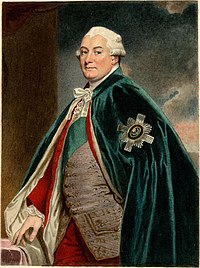David Murray, 2nd Earl of Mansfield
The Earl of Mansfield KT, PC | |
|---|---|
 | |
| Lord President of the Council | |
| In office 17 December 1794 – 1 September 1796 | |
| Monarch | George III |
| Prime Minister | William Pitt |
| Preceded by | The Earl FitzWilliam |
| Succeeded by | The Earl of Chatham |
| In office 2 April 1783 – 19 December 1783 | |
| Monarch | George III |
| Prime Minister | The Duke of Portland |
| Preceded by | The Lord Camden |
| Succeeded by | The Earl Gower |
| Secretary of State for the Northern Department | |
| In office 27 October 1779 – 27 March 1782 | |
| Monarch | George III |
| Prime Minister | Lord North |
| Preceded by | The Viscount Weymouth |
| Succeeded by | Office Abolished The Earl of Shelburne as Home Secretary Charles James Fox as Foreign Secretary |
| Personal details | |
| Born | David Murray 9 October 1727 |
| Died | 1 September 1796 (aged 68) |
| Resting place | Westminster Abbey (body) Comlongon Castle (heart) |
| Spouse(s) | |
| Relations | William Murray, 1st Earl of Mansfield (paternal uncle) |
| Children |
|
| Parents |
|
| Alma mater | Westminster School Christ Church, Oxford |
| Occupation | Politician |
David Murray, 2nd Earl of Mansfield, 7th Viscount of Stormont, KT, PC (9 October 1727 – 1 September 1796), known as The (7th) Viscount of Stormont from 1748 to 1793, was a British politician. He succeeded to both the Mansfield and Stormont lines of the Murray family, inheriting two titles and two fortunes.
Background[]
Mansfield was the son of David Murray, 6th Viscount of Stormont, and his wife Anne Stewart. Lord Chief Justice William Murray, 1st Earl of Mansfield, was his paternal uncle.
Public life[]
Mansfield was ambassador to Vienna and Warsaw and then to France in the early years of the American War of Independence, and played a role in sending news of American actions back to England. He had been elected a Scottish Representative Peer in 1754. He was appointed as the last Secretary of State for the Northern Department, serving from 1779 to 1782.
In 1783 he was appointed as Lord President of the Council, and again from 1794 to 1796. He served as Lord Justice General between 1778 and 1795. He was appointed a Privy Counsellor in 1763 and made a Knight of the Thistle in 1768.
Family[]

Lord Stormont, as he then was, married his wife on 16 August 1759, whilst he was British ambassador to Saxony. She was Henrietta Frederica von Bünau, daughter of Henry Graf von Bünau. They had two daughters:
- Lady Elizabeth Murray (18 May 1760 – 1 June 1825); married George Finch-Hatton and had issue, including George Finch-Hatton, 10th Earl of Winchilsea.
- Hon. Henrietta Anne Murray (16 October 1764, Dresden – circa 1765, Vienna)
Henrietta died on 10 March 1766. A decade later, on 5 May 1776, Mansfield married secondly the Honourable Louisa Cathcart, daughter of Charles Cathcart, 9th Lord Cathcart. Louisa was his junior by more than 30 years, and they had five children:
- David William Murray, 3rd Earl of Mansfield (1777–1840)
- Lt.-Gen. Hon. George Murray (1780–1848)
- Major Hon. Charles Murray (1781–1859), who married Elizabeth Law and had children
- General Hon. Sir Henry Murray (1784–1860), who married Emily, daughter of Gerard de Vismé, and had children.[1]
- Lady Caroline Murray (died 1867)
In 1793 he succeeded his uncle the first Lord Mansfield as the second Earl of Mansfield of the 1792 creation, while his wife succeeded as second Countess of Mansfield of the 1776 creation, according to special remainders in the letters patent. From the 1st Earl he inherited Kenwood House in the London Borough of Camden.
Lord Mansfield died in September 1796 and his body laid to rest with his uncle, the 1st Earl, in Westminster Abbey.[2] His heart was interred in Comlongon Castle. He was succeeded in his titles and to Kenwood House by his eldest son David. His second son, the Honourable George Murray, became a Lieutenant-General in the Army. His fourth son, the Honourable Sir Henry Murray, rose to the rank of General.
The Countess of Mansfield survived her husband by 47 years. She went on to marry her first cousin the Honourable Robert Fulke Greville in 1797. Lady Mansfield died in July 1843, aged 85.
See also[]
References[]
- ^ Dalton, Charles (1904), The Waterloo roll call. With biographical notes and anecdotes, London: Eyre and Spottiswoode, p. 91
- ^ "William Murray, Lord Mansfield". Westminster Abbey. Retrieved 24 January 2018.
- Kidd, Charles, Williamson, David (editors). Debrett's Peerage and Baronetage (1990 edition). New York: St Martin's Press, 1990,[page needed]
- Tugdual de Langlais, L'armateur préféré de Beaumarchais Jean Peltier Dudoyer, de Nantes à l'Isle de France, Éd. Coiffard, 2015, 340 p. (ISBN 9782919339280).
- Leigh Rayment's Peerage Pages [self-published source][better source needed]
- Lundy, Darryl. "FAQ". The Peerage.[unreliable source]
Further reading[]
- Stacy Schiff (2005). A Great Improvisation. New York: Henry Holt and Company. ISBN 9780805066333.
External links[]
- Lundy, Darryl. "p. 2854 § 28539". The Peerage.
- 1727 births
- 1796 deaths
- Clan Murray
- Diplomatic peers
- Earls of Mansfield
- Lord Presidents of the Council
- Lords Justice-General
- Members of the Privy Council of Great Britain
- Scottish representative peers
- Secretaries of State for the Northern Department
- Ambassadors of Great Britain to France
- Ambassadors of Great Britain to Poland
- Earls in the Jacobite peerage
- Ambassadors of Great Britain to the Holy Roman Emperor
- 18th-century British politicians
- Leaders of the House of Lords
- Burials at Westminster Abbey

